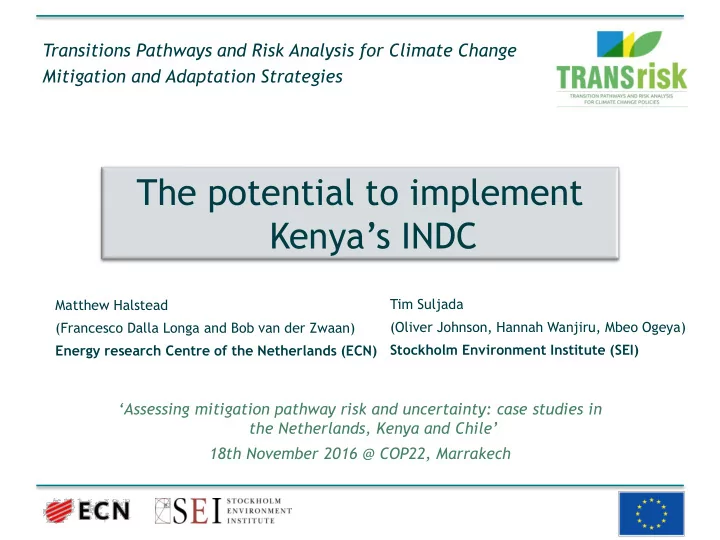

Transitions Pathways and Risk Analysis for Climate Change Mitigation and Adaptation Strategies The potential to implement Kenya’s INDC Tim Suljada Matthew Halstead (Oliver Johnson, Hannah Wanjiru, Mbeo Ogeya) (Francesco Dalla Longa and Bob van der Zwaan) Stockholm Environment Institute (SEI) Energy research Centre of the Netherlands (ECN) ‘Assessing mitigation pathway risk and uncertainty: case studies in the Netherlands, Kenya and Chile’ 18th November 2016 @ COP22, Marrakech
P URPOSE Provide a sample of our scenario analysis results which complement ongoing broader research in Kenya Purpose of the analysis: • Explore the necessity of large-scale RE deployment with respect to Kenya’s GHG abatement ambitions (INDC): Focus on power and energy demand sectors Compare the Kenya INDC emissions projection with a range of climate policy • scenarios up to 2030; make projections beyond to 2050.
K ENYA ’ S INDC 150 150 GHG emissions [MtCO 2 e] GHG emissions [MtCO 2 e] 120 120 90 90 60 60 30 30 0 0 2010 2015 2020 2025 2030 2010 2015 2020 2025 2030 LULUCF Agriculture Energy & Power Transportation Industry & Waste BAU NDC BAU excl. LULUCF NDC excl. LULUCF • Kenya’s BAU emissions projections from the Second National Communication • Uncertainty in LULUCF data, thus excluded from our analysis (right hand chart) • 30% emissions reduction compared to BAU in INDC; 20% reduction excl. LULUCF We focus on blue area in our analysis – energy and power sector •
E MISSION T RAJECTORIES : A LL S CENARIOS Scenarios from global TIAM-ECN work. Starting point for other scenarios relevant to Kenya • 20% emissions reduction in TIAM-ECN: NDC scenario excl. LULUCF (30% reduction in Kenya INDC) • INDC target plausible from an energy system and cost-optimality perspective • • Additional costs in 2050 of US$16 bln annually in NDC scenario (Kenya GDP (2015) is 63 bln US$)
R ESULTS : F INAL ENERGY CONSUMPTION [EJ] 2010 • Energy consumption currently dominated by use of biomass and oil (imported) • In REF scenario (no GHG mitigation policies) mostly coal and oil products • In NDC scenario coal and nuclear constrained; large role for Geothermal and Biomass
Why is biomass and charcoal important in Kenya? Wood and charcoal is estimated at 68% of • Projected annual biomass (wood & charcoal) final energy consumption energy consumption and supply Charcoal consumption is much higher than • 60,000 Annual supply/consumption (tonnes/year) sustainable supply Consumption (tonnes/yr) 50,000 • GHG emissions reduction opportunities in value chain, but it is complex 40,000 Deficit (tonnes/yr) Charcoal 30,000 Retail conversion Wholesale Sustainable 20,000 supply (tonnes/yr) 10,000 0 2000 2005 2010 2020 Biomass Transportation Consumer Year production What are the incentives for change for actors in the value chain? How can actors and networks support innovation towards sustainable charcoal? Graphic: Oliver Johnson Chart: Ministry for Environment, Water and Natural Resources
K EY MESSAGES • Kenya’s NDC target is achievable with a timely deployment of RE; deeper emission reductions possible • Complex and challenging societal shift going beyond energy sector e.g. sustainable charcoal Charcoal production technologies: b rick kiln, traditional earth kiln and improved earth kiln respectively
N EXT STEPS / OPEN QUESTIONS • How could Kenya attract private capital to finance INDC implementation? What support other than financial is needed? Who should provide this support? • What other factors should we be considering in our scenarios and case study?
Recommend
More recommend